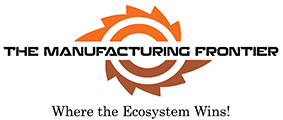“Manufacturing remains one of the biggest contributors to material waste, accounting for close to 40% of the global total, according to Forbes. At the same time, advancements in artificial intelligence (AI)—which saw over $200 billion in global investment in 2024—are opening new opportunities to optimize production processes, particularly in quality control.” Dr. Wilhelm Klein, CEO & Co-Founder, Zetamotion
As we move through 2025, the pressure on manufacturers to produce more with less has never been greater. Sustainability is no longer a buzzword—it’s an operational necessity. Reducing emissions, minimizing waste, and improving efficiency are now integral to staying competitive in a changing global market.
Manufacturing remains one of the biggest contributors to material waste, accounting for close to 40% of the global total, according to Forbes. At the same time, advancements in artificial intelligence (AI)—which saw over $200 billion in global investment in 2024—are opening new opportunities to optimize production processes, particularly in quality control.
This shift is particularly significant in India, where manufacturing is poised to become a cornerstone of economic growth. With strong sectors in automotive, engineering, chemicals, and pharmaceuticals, India is projected to export goods worth $1 trillion by 2030. As the country moves from an import-dependent economy to a global production hub, ensuring quality at scale will be essential.
“Quality control plays a critical role in minimizing resource waste. Missed defects, over-scrapping, and unnecessary reworks contribute to excess material use, downtime, and energy loss. Automating inspection with AI helps address these inefficiencies, offering faster detection, better adaptability to product changes, and more consistent results.”
Quality Control and the Efficiency Gap
Quality control plays a critical role in minimizing resource waste. Missed defects, over-scrapping, and unnecessary reworks contribute to excess material use, downtime, and energy loss. Automating inspection with AI helps address these inefficiencies, offering faster detection, better adaptability to product changes, and more consistent results.
However, many AI systems plateau around 80% detection accuracy. In high-stakes industries—such as aerospace or electronics—this isn’t enough. The jump from 80% to 99% accuracy, often called the “last mile,” has traditionally required large volumes of labelled data and frequent retraining. It’s costly, time-consuming, and hard to sustain.
“When a new product is introduced, the cycle begins again: collect new data, label thousands of images, and retrain the model. This makes scalability difficult, especially in high-variation or fast-moving environments.”
Data: The Core Constraint
A major challenge lies in the data itself. According to MIT Technology Review Insights, 57% of manufacturing executives say data quality is the biggest obstacle to AI adoption. Inconsistent lighting, sensor drift, and rare but critical defect types limit the usefulness of real-world datasets.
When a new product is introduced, the cycle begins again: collect new data, label thousands of images, and retrain the model. This makes scalability difficult, especially in high-variation or fast-moving environments.
Synthetic Data: A Way Forward
To bypass these limitations, manufacturers are increasingly exploring synthetic data—computer-generated datasets that mimic real production conditions. Synthetic data can simulate rare defects, variable lighting, and different materials without the need for manual collection or labelling.
Instead of waiting for defects to occur naturally, engineers can create them digitally, train the model, and deploy it in days instead of months.
As Elon Musk recently noted: “We’ve now exhausted basically the cumulative sum of human knowledge … in AI training… The only way to supplement real-world data is with synthetic data, where the AI creates training data. With synthetic data, AI will sort of grade itself and go through this process of self-learning.” (TechCrunch, 2025).
Synthetic data not only accelerates development but also helps models generalize better across production scenarios—something especially useful in dynamic, diversified manufacturing contexts like India’s.
“Imagine training a new QC worker. Instead of handing them thousands of labelled images, you show them a few examples, provide a defect catalogue, and let them learn from an expert. After a short while, they say, ‘Okay, I get it.’ This is a form of data synthesis—learning through context and extrapolation.”
Learning Like a Human
This approach mirrors how people learn. Imagine training a new QC worker. Instead of handing them thousands of labelled images, you show them a few examples, provide a defect catalogue, and let them learn from an expert. After a short while, they say, ‘Okay, I get it.’ This is a form of data synthesis—learning through context and extrapolation.
This human-like, contextual learning enables faster deployment of AI inspection systems, especially in facilities handling multiple product variants or frequent design changes.
Keeping People in the Loop
Despite the progress of automation, experienced workers remain essential. Many manufacturers are adopting Human-in-the-Loop (HITL) systems, where operators review and adjust AI decisions, particularly in edge cases. Their feedback improves the model’s performance over time.
This hybrid approach balances the speed of automation with the insight of skilled professionals—preserving operational knowledge while building more adaptable systems.
Looking Ahead
For countries like India, where manufacturing is expanding rapidly, combining synthetic data, AI, and human expertise offers a practical path to scalable quality control. It helps reduce material waste, improve accuracy, and shorten the time needed to adapt to new products or regulations.
Yet, technology alone doesn’t deliver these outcomes. Success hinges on selecting the right collaborators—teams that understand both the technical demands and the realities of modern manufacturing.
Because in the race toward sustainable, high-performance production, the real differentiator isn’t just what you use—it’s who you build it with. And the future of quality control is too important to face alone.
The author, Dr. Wilhelm Klein, is the CEO & Co-Founder of Zetamotion. He can be reached at klein@zetamotion.com

